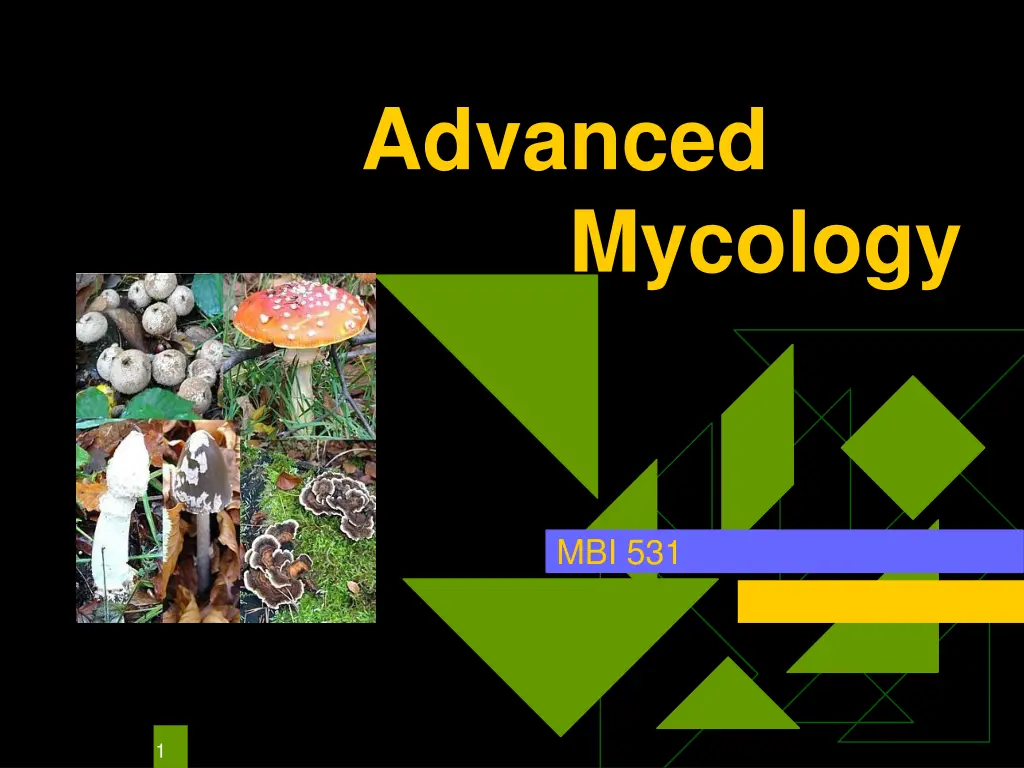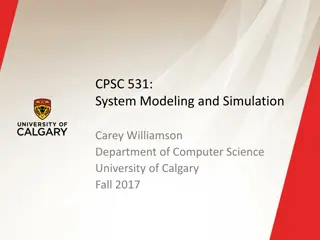
Advanced Mycology: Introduction to Mushroom Fungi Classification
Learn about the fascinating world of mushroom fungi in this advanced mycology course. Explore the different types of fungi, their cell morphology, classification based on sexual spore formation, and more. Discover the uniqueness of yeasts, molds, dimorphic fungi, and systemic classifications in this comprehensive study.
Download Presentation

Please find below an Image/Link to download the presentation.
The content on the website is provided AS IS for your information and personal use only. It may not be sold, licensed, or shared on other websites without obtaining consent from the author. If you encounter any issues during the download, it is possible that the publisher has removed the file from their server.
You are allowed to download the files provided on this website for personal or commercial use, subject to the condition that they are used lawfully. All files are the property of their respective owners.
The content on the website is provided AS IS for your information and personal use only. It may not be sold, licensed, or shared on other websites without obtaining consent from the author.
E N D
Presentation Transcript
Advanced Mycology MBI 531 1
Introduction Mykes (Greek word) : Mushroom Fungi are eukaryotic protista; differ from bacteria and other prokaryotes. Cell walls containing chitin (rigidity & support), mannan & other polysaccharides Cytoplasmic membrane contains ergosterols Possess true nuclei with nuclear membrane & paired chromosomes. Divide asexually, sexually or by both Unicellular or multicellular 1. 2. 3. 4. 5. 11.10.09 2
Introduction Simplest fungus :- Unicellular budding yeast Hypha :- Elongation of apical cell produces a tubular, thread like structure called hypha Mycelium :- Tangled mass of hyphae is called mycelium. Fungi producing mycelia are called molds or filamentous fungi. Hyphae may be septate or non-septate 11.10.09 3
CLASSIFICATION Depending on cell morphology Yeasts Yeast like fungi Molds Dimorphic fungi 1. 2. 3. 4. 11.10.09 4
1. Yeasts Unicellular fungi which reproduce by budding On culture - produce smooth, creamy colonies e. g Cryptococcus neoformans (capsulated yeast) 11.10.09 5
2. Yeast like fungi Grow partly as yeasts and partly as elongated cells resembling hyphae which are called pseudohyphae. e.g. Candida albicans 11.10.09 6
3. Molds/ Filamentous fungi Form true mycelia & reproduce by formation of different types of spores. Vegetative/ aerial hyphae e.g. Rhizopus, mucor 11.10.09 7
4. Dimorphic fungi Occur in 2 forms Molds (Filaments) 25 C (soil) Yeasts 37 C (in host tissue) Most fungi causing systemic infections are dimorphic: Histoplasma capsulatum Blastomyces dermatidis Paracoccidioides brasiliensis Coccidioides immitis Penicillium marneffei Sporothrix schenkii 11.10.09 8
Systemic classification Based on sexual spore formation: 4 classes Zygomycetes Ascomycetes Basidiomycetes Deuteromycetes (fungi imperfectii) 1. reproduce sexually 2. 3. 4. 11.10.09 9
1. Zygomycetes Lower fungi Broad, nonseptate hyphae Asexual spores - Sporangiospores: present within a swollen sac- like structure called Sporangium 11.10.09 10
1. Zygomycetes Sexual spores - Zygospore: a resting, thick walled cell in between hyphae e.g. Rhizopus, Mucor,Absidia 11.10.09 11
2. Ascomycetes Includes both yeasts & filamentous fungi Narrow, septate hyphae Asexual spores are called conidia borne on conidiophore 11.10.09 12
2. Ascomycetes Sexual spores called ascospores are present within a sac like structure calledAscus. Several asci may be seen within a fruiting body as seen in Penicillium, Aspergillus Each ascus has 4 to 8 ascospores. 11.10.09 13
3. Basidiomycetes Sexual fusion results in the formation of a club shaped organ called base or basidium which bear spores called basidiospores 11.10.09 14
4. Deuteromycetes or Fungi imperfectii Group of fungi whose sexual phases are not identified. Grow as molds as well as yeasts. Asexual stage conidia e.g. Candida, Cryptococcus 11.10.09 15
Vegetative Structures of Fungi Formed by the vegetative mycelia (modification of single vegetative cells or hyphae) Have no reproductive value Important in the differentiation/ identification of clinically significant fungi. 11.10.09 16
Spiral hyphae in T .Mentagrophytes 11.10.09 17
Vegetative Structures of Fungi Arthrospores formed by segmentation & condensation of hyphae Chlamydospores thick walled resting spores e.g. C.albicans 11.10.09 18
Reproduction in fungi Sexual by formation of zygospores, ascospores or basidiospores Asexual By budding or fission Spores (conidia) are formed on or in specialized structures. Spores vary in size, shape & colour but these characteristics are constant for a particular species. 11.10.09 19
Reproduction in fungi Micro conidia - Small, single celled Macro conidia Large, single or many celled 11.10.09 20
Fungal Infections/ Mycoses Superficial mycoses: 2 types: surface and cutaneous mycoses Skin, hair & nails. Mild but chronic disease Deep mycoses: 2 types: subcutaneous & systemic mycoses Caused by soil saprophytes Infection is accidental Range from a symptomatic infection to fatal disease 11.10.09 21
Superficial: Surface mycoses Live exclusively on dead surfaces of skin and its appendages No contact with living tissue, hence no inflammatory response Tinea versicolor Tinea nigra Piedra 1. 2. 3. 11.10.09 22
Superficial: Cutaneous mycoses Cornified layer of skin & its appendages Contact with living tissue, hence inflammatory & allergic responses seen Dermatophytes skin, hair & nails 3 genera - Trichophyton Microsporum Epidermophyton 1. 2. 11.10.09 23
Deep mycoses Subcutaneous mycoses Mycotic Mycetoma Chromoblastomycoses Sporotrichosis Rhinosporidiosis Subcutaneous phycomycoses Systemic mycoses Cryptococcoses Blastomycosis Paracoccidiomycoses Coccidioidomycoses Histoplasmoses 1. 1. 2. 2. 3. 3. 4. 4. 5. 5. 11.10.09 24
Candidiasis Caused by candida sps, forms a bridge between superficial & deep mycoses as it can cause cutaneous as well as systemic infections Can also cause opportunistic infections 11.10.09 25
Opportunistic infections Pts with debilitating disease, altered physiological state Mainly caused by fungi which are common lab contaminant on culture media Aspergillus Pencillium Mucor Rhizopus Produce serious & fatal infections 11.10.09 26
Useful Properties of Fungi Source of food e.g. mushrooms Antibiotic production e.g. Penicillin from Penicillium notatum Fermentation - Production of alcohol, bread e.g. Sacchromycesspps 11.10.09 27
Useful Properties of Fungi Ergot from Claviceps purpurea, used to induce uterine contractions Vaccines for Hepatitis B Sacchromyces cerevisiae 11.10.09 28





